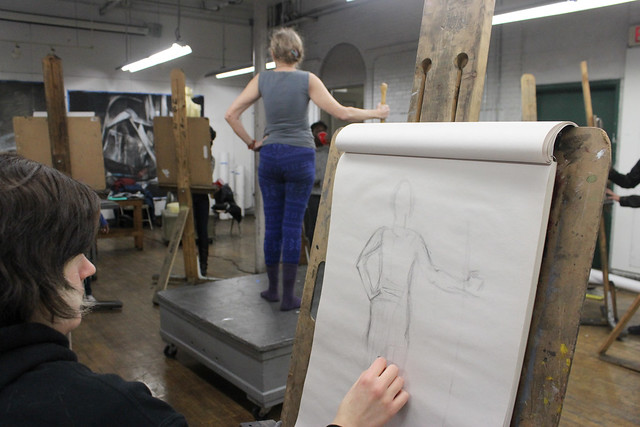
“What is a gesture drawing?”
A gesture drawing is basically a quick drawing that captures the essential gesture of a subject in its most distilled form. Gesture is everywhere, embodied in every object, person, and place. It is action, emotion, movement, and expression all rolled together into one cohesive motion. Through gesture, your drawing can transform into anything from ferocious to quiet.
In the video tutorial below, Art Prof Teaching Artist Alex Rowe does gesture drawings of sheep from life as resource material for creating an illustration.
In drawing, gesture represents the primal instinct, the essential character of the subject. As a form of expression, an initial gesture drawing is critical to every drawing. Without a sense of gesture, drawings become sterile and static.
Drawings lacking gesture become dull and mechanical. Instilled with gesture, a drawing is able to communicate emotion and expression in a concentrated manner that is visually compelling. Through gesture, the essential character and emotion of any given subject can be effectively communicated.
A sense of fluidity is one of the key components of a successful gestural drawing. This is achieved when a drawing conveys a focused, single motion that allows the object to be perceived as a whole, rather than as a series of unrelated pieces. Essentially, this brings together all of the parts and assembles them into a harmonious, cohesive statement. Fluidity can be achieved in a number of different ways.
The manner in which marks are created on the surface of the page can play a major role in attaining fluidity. Marks that continually flow and move into each other will tend to behave as a whole. An emphasis on the relationships of the big shapes, examining how they transition into each other can also be highly effective.
Student gesture drawing
4 steps on how to make a gesture drawing:
1) Start with very light, loose, and sketchy marks.
Keep a sensitive touch with your drawing tool, initially drawing so lightly that you are barely making physical contact with the paper as you draw. Staying light will allow for more flexibility as you continue working on the drawing. Working without an eraser will also allow you to work more fluidly, continually move forward, and accept and deal with your mistakes, rather than backtracking all the time with an eraser.
In this video tutorial below, you can watch Art Prof Teaching Artist Casey Roonan start his charcoal self-portrait with very light, sketchy marks using vine charcoal.
2) Draw with one very light, continuous line that never leaves the surface of the paper.
Concentrate on seeing the whole shape all at once. This will allow you to work with more fluidity, as opposed to chopping up your marks into disconnected parts. Remember that your first lines will not be “right”, this initial stage is only about getting something on the paper at first. You have to draw it wrong before you can draw it right.
3) Focus the drawing on first blocking in the largest shapes.
Eventually move consecutively towards medium and small shapes. Leave out the details in these early stages of the drawing and concentrate solely on the big shapes. Look for how one large shape transition into each other, and stay focused on the relationships between these shapes.
In this video tutorial below, you can watch me block out the largest shapes on the face before going into the details.
4) Engage with the entire image all at once.
All areas of the drawing need to be given equal treatment and attention. Don’t allow for one area to be ignored or for another to be finished before the others. All of the parts of the drawing should be developed at the same level of completion at all times. Keep your eye alert and active while physically moving your hand around the page.
This charcoal drawing tutorial I did shows the entire process of creating a portrait drawing in charcoal from direct observation. The initial part of sketching in this drawing seen in this tutorial follows the basic principles of gesture drawing.
Artprof.org is a free website for learning visual arts which features video tutorials, art critiques, and more.


thank you for the details
Reblogged this on jonathanvaldezart.